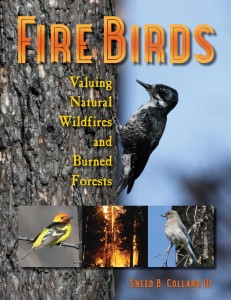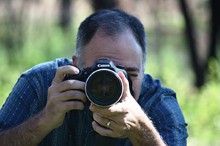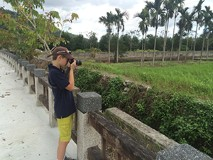Fire Birds
Fire Birds: Valuing Natural Wildfires and Burned Forests by Sneed B. Collard III. 2015. Bucking Horse Books.
Genre: Nonfiction science picture book.
Ages: For readers 8 to 14.
Review by Vicki Spandel
Summary
Most of us have been taught that wildfires are a bad thing—and that’s true when they threaten homes or lives. In the wilderness, however, wildfires can be an essential part of the natural life cycle. Fire Birds shows how dozens of bird species not only survive, but actually thrive in burned areas, depending on burns to create a unique and essential habitat that cannot be generated any other way.
In this book, readers discover that natural wildfires are anything but a contemporary phenomenon; they have been with us throughout time. And while they can be intensely frightening and destructive, the news is not all bad. Wildfires actually generate life, especially when allowed to follow their natural course. Intervention by humans can create a situation where fire fuels grow and expand so profusely that fire cannot be stopped or contained. Good intentions do not always lead us down the best path.
This book does not endorse allowing any fire to go unchecked if it threatens homes or human lives. But it does help us recognize the benefits that natural occurring fires bring—not only habitat for many types of wild birds, but also fertile soil for regeneration of countless trees and shrubs that create natural, multi-species forests. Naturally occurring fires also clear the forest of underbrush which, if allowed to grow unchecked, presents an unthinkable danger to plants, animals, and any humans happening to reside nearby. It is time, as the author tells us, to update Smokey Bear’s message.
Inside Your Classroom
1. Background. Is wildfire common in your area? Perhaps some of your students (or you) have witnessed a wildfire, watched media coverage, or even been evacuated. Take time to discuss the frequency and severity of fires in your area, particularly in recent years, inviting students to share experiences of their own. How do your students feel about wildfires prior to experiencing this book? (Note: This can be a sensitive topic for students who have suffered loss as a result of fire, so we recognize your need to pursue this discussion with awareness and caution.)
2. The title: Inference and prediction. A title like Fire Birds could well apply to a sci fi adventure! This is a science book, of course. So where did this title probably come from? What hints does it provide about the likely theme or central message of the book?
3. Sharing the book. As always, you’ll want to preview the book prior to sharing it with students. At just under 50 pages, it is a quick read for an adult, and the combination of fascinating information, enticing illustrations, and strong sense of drama make it an inviting text for young readers who favor nonfiction or have an interest in nature. This book is highly recommended for use with a study group. If you decide to share it with the whole class, a document projector is all but essential since the illustrations are an integral element of the book’s message.
4. Introduction. As the Common Core standards for writing remind us, a good introduction sets the stage for what follows. Share the introduction titled “Inferno!” aloud with students, using a document projector to share the accompanying illustration of a wildfire as you do so. Ask students to listen for words or phrases that catch their attention (notably verbs), and make a class list. You may wish to read the passage more than once to facilitate this. What impression is the author creating with this passage? Is it effective in setting the stage for the discussion to come? Does it capture our attention? How? In particular, notice the final line, a three-word question. Why is this question particularly important? Ask how many of your students have used a question as part of their writing strategy in crafting an introduction.
5. Organizational structure. Check out the Table of Contents. It’s very colorful! Do your students like the format? Notice that although this is not a long book (about 50 heavily illustrated pages, including appended material), it’s broken into an introduction plus five chapters. Does breaking a text up in this way help readers? How? Notice that the chapters are not only numbered, but also have titles. See if your students can use these titles to orally trace the writer’s thinking, point to point, even prior to reading the book. Are their expectations borne out as they read the text?
6. Main idea. What is this author’s main idea or message? Pose this question after sharing Chapter 1—and ask students to summarize the main idea in their own words. Then, revisit the question after getting deeper into the book. Students may not change their minds, but their ability to elaborate on the main idea will likely grow. You might also ask them to listen for a sentence or paragraph they feel sums up the author’s primary message. (Note: Check out the final paragraph on page 30 for one good possibility. Also notice the quotation attributed to Dick Hutto on page 8.)
7. Details. Details take many forms, according to the Common Core: facts, examples, explanations, quotations from experts, illustrations, and more. See how many of these various forms your writers can identify in Fire Birds. Ask how many they use in their own writing. You may want to point out that varied detail enriches writing. No one wants to read text that is all facts, for example. The mind craves variety, and learns more easily when given multiple paths to information. What kinds of details do your students respond to as readers?
8. Format. In addition to chapter titles, author Sneed Collard also makes extensive use of subheads throughout the book. How do these contribute to the organization of the book—and also the sharing of information? To put it another way, do they make the book easier to follow? How? Also notice the boxed information embedded in many of the illustrations. Do these little boxes have something in common? Talk about why the author chose to use this approach rather than simply incorporating this additional information into the regular flow of the text. Is this format effective? Why? Talk about how/when students might use a similar strategy in their own writing.
9. Illustrations. Book designers often say that illustrations and words should complement, not replicate, each other. That is, each should provide information that the other does not. Read the information on page 15 and the first paragraph of page 16 aloud as your students study the photos on page 14. What do we learn from each (illustrations and words) that we do not learn from the other?
10. Research. Many books, including novels, rely on research for authenticity. But nowhere is research more important than in an informational text like this one. Discuss why this matters so much. If the book were based strictly on Collard’s opinion or observations made in his back yard, would it be as convincing? Discuss how and where this author searched for his information. On a scale of 1 to 10, how credible is this research, in your students’ view? (Note that much of the book is based on the work of ornithologist Dick Hutto, described on pages 17 through 19. Students should also be aware that Collard spent extensive time in the field himself, interviewed additional specialists, and also took the photos that illustrate the book. Also point out the extensive additional sources listed in “Digging Deeper,” page 46. Your students may wish to explore some of these resources.)
11. Transitions. Transitions, the CCSS remind us, are vital ways to link ideas in all forms of writing: narrative, argument, and information. In introducing this discussion, see if your students can list 20 transitional words or phrases (however, next, for example, on the other hand, because, nevertheless, and so on). Sneed Collard is an author noted for the strong transitions that make his work so easy to read and follow. Share one or both of the following passages with students and ask them to identify as many transitions as they can—and to discuss how each links ideas: “Home, Sweet Blackened Home,” beginning of Chapter 3, page 21; and “Beetle Bonanza,” page 24. Keep in mind that good transitions are often more than a word long and may occur mid-sentence. Also, there may be more than one transitional phrase within a given sentence. (Note: Permission is granted to print and distribute these pages to your students. They can talk with partners, and identify transitions orally or use highlighters to mark up the text.)
12. Transitional endings. One of the delightful things about a chapter book is that it provides multiple opportunities to consider beginnings and endings. Chapter endings are particularly important because when a reader comes to the end of a chapter, it’s always tempting to find something else to do! No author wants readers to do that! Notice for example the ending to Chapter 2, bottom of page 19: “What he found astonished him.” What is the likely impact of these words on the reader? How does this line provide a transition into Chapter 3?
13. Word choice. Words always matter. In informational writing, though, they can be particularly important because, as we’re reminded in the CCSS, an author must use “domain-specific vocabulary”—what we might call the language of the territory—in order to help us understand a particular topic: in this case, wildfire and its effect on birds’ habitats. This particular book has a special feature—a glossary—to help with word definitions. As you go through the text (and without peeking at the glossary), have students list words they think should be defined. Check your final list against the glossary at the end of the book. Also note how well some terms are defined in context—by how they are used, that is. See, for example, “salvage logging” on page 32.
14. Voice and tone. The Common Core suggests that an informational piece should have an “objective, formal tone,” which some might describe as respectful of the topic or free of personal bias. Does the author achieve that? Identify three or more passages that are good examples of the voice or tone you hear in this book. Brainstorm all the words you can think of that describe these passages: e.g., serious, engaging, thoughtful, humorous, energetic, dramatic, exciting, passionate, reflective. (Note: Reading aloud makes it easier for most students to describe a given text.)
15. Reading graphics. In addition to numerous illustrations, author Sneed Collard includes an important graphic titled “’Hottest’ Fire Birds” on page 25. Ask students to summarize, in a few short lines, the message of this graphic. How does it support the author’s main message?
16. Genre. The author makes a strong case for encouraging us to see wildfires (those that do not threaten human lives or residences) in a positive way. So—should this book be classified as an argument? Or an informational text? Have students write a response, taking a position on this and defending it with examples from the book. (Note: You may wish to access the CCSS definitions to help students make a decision on this.)
17. Crafting an argument. At the close of Chapter 3, page 26, Collard makes a particularly strong statement based on Dick Hutto’s research: “Perhaps humans should stop looking at naturally caused fires as our enemy and start looking at them as an essential part of nature.” Do your students agree? Have them take a position and make an argument for or against the “essential part of nature” position, using information not only from this book, but other sources as well.
18. Impact of the book. Good informational writing should teach readers something new—or at least expand their understanding of a topic. What do your students learn from this book? Make a list of new ideas, surprises, or discoveries. Take a moment to re-examine the reactions to wildfires students expressed prior to reading the book. Have their opinions or feelings changed in any way?
19. Conclusion. In a sense, all of Chapter 5 is a conclusion. But the author also offers an expanded concluding statement in the section titled “Still Work to Do,” page 42 and following. How strong is this conclusion? What thoughts or beliefs do your students think the author wants us to take away from this reading experience?
20. Personal research. Ask students to extend their learning by visiting a burn site, interviewing local firefighters, researching the impact of fires in their home state or elsewhere, following up with resources listed under “Digging Deeper,” page 46, or even observing and photographing wild birds in a new burn habitat if there is one close by. Invite them to share their findings.
About the author . . .
Author Sneed B. Collard III graduated with honors in biology from the University of California at Berkeley and earned his masters in scientific instrumentation from U. C. Santa Barbara. He is the author of more than 65 books for younger readers, including Animal Dads, Teeth, The Prairie Builders, Pocket Babies and Other Amazing Marsupials, and Sneed B. Collard III’s Most Fun Book Ever About Lizards. To learn more about Sneed or schedule a school or conference visit, please go to his website, www.sneedbcollardiii.com or the website of his publishing house, Bucking Horse Books, www.buckinghorsebooks.com
Coming up on Gurus . . .
Jeff will be sharing reviews of some of the best literature to enter his life of late—but he doesn’t want to share titles just yet! They’re a surprise. Jeff always chooses the most readable, memorable books, though, so you’ll want to keep an eye out for those reviews. Thank you for stopping by, and as always, we hope you will come often and bring friends. Please remember . . . to book your own writing workshop featuring the 6 traits, Common Core Standards and the latest and greatest in young people’s literature, give us a call: 503-579-3034. Meantime . . . Give every child a voice.





